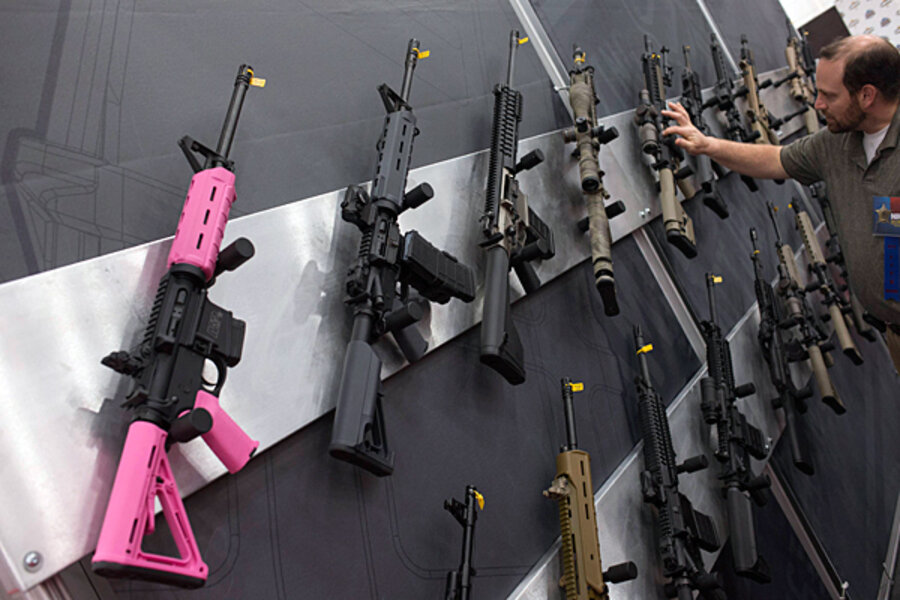With gun violence down, is America arming against an imagined threat?
Loading...
| Atlanta
Mass shootings, frantic gun-buying, and more Americans legally carrying guns on the street all point to a country fighting a gun violence epidemic, right?
Not necessarily.
As part of a broader trend of declining crime, gun violence in America – while still high relative to other Western countries – has dropped by 49 percent from 1993 to 2011, while nonfatal gun crimes dropped by 69 percent, according to the US Justice Department.
But that slow-motion decline in Americans turning guns on each other has failed to register with most people, only 12 percent of whom answered the question correctly when asked by the Pew Research Center in a poll released Tuesday. Some 56 percent of respondents said they believed that gun violence had actually increased over the last 20 years.
The reasons for the perception gap are manifold, including a steady stream of high profile shootings and massacres, an increased focus on crime by national media and cable networks, and partisan sniping about gun politics. But the gap is so huge, agrees D’Vera Cohn, a senior writer at Pew, in an AP interview, that it’s hard to explain.
America is still bleeding from gun violence, make no mistake. Some 12,343 people were killed by guns in 2010, keeping the US at the top of the most violent Western countries. The US also has more guns, per capita, than any other Western country, with at least 310 million and as many as 400 million firearms in circulation.
Since 1993, the rate of gun violence dropped by the greatest degree in the 1990s and has stayed relatively stable since the early 2000s. But recent years have witnessed a dramatic shift in US gun culture, with millions of Americans getting certified to carry concealed weapons and women increasingly joining the ranks of gun owners.
An estimated 8 million Americans now have concealed weapons permits, and thousands wear guns openly in the 43 states that allow it. Atlanta Police Chief George Turner told the Monitor recently that urban police no longer automatically assume a citizen wearing a gun is in the process of committing a crime, as they did just a few years ago.
In a separate survey, Pew found in March that 49 percent of gun owners keep firearms for protection today, compared with 26 percent who said the same in 1999. In other words, it appears that perceptions about the rate of violent crime are partly responsible for the growth of gun ownership across the US in the last 20 years, a trend only helped along by Supreme Court decisions and state laws that have increasingly backed greater gun rights.
“The gun prohibition lobby has long promoted this idea that reducing the number of guns is a good idea, that fewer guns are better categorically,” says Dave Kopel, a research analyst at the Independence Institute in Denver. “But here we have a real world experiment which shows the opposite, where we have a huge decline in gun crime at the same time as there’s been an enormous increase in the firearms supply in the United States. It doesn’t prove that the increase in gun numbers or licensed carry caused the decline, but it sure does contest the simplistic theory … that more guns equal more crime.”
The paradox provides a poignant backdrop for a national gun debate that had primarily Democrats but also key Republicans pushing for more gun controls, including expanded background checks, in the wake of a string of mass murders culminating last December in the shocking massacre of 20 grade-school children in Newtown, Conn., by a disturbed, alienated 20-year-old.
Those who support putting more restrictions on gun ownership say the perception gap about gun violence doesn’t ultimately take away from the need to address the sheer volume of gun violence in the United States.
"None of these studies change the impact of Newtown and other recent mass slayings, showing the need for common sense measures" restricting guns, Sen. Richard Blumenthal, (D) of Connecticut, told the Associated Press.
Yet coming three weeks after the Senate declined to endorse expanded background checks despite support for that idea from 83 percent of Americans, the new poll at the very least adds interesting new fodder for an ongoing gun policy debate.
Vice President Joe Biden, who led President Obama’s commission on gun violence in the wake of Newtown, has vowed to reintroduce background check legislation. And New York Mayor Michael Bloomberg’s Mayors Against Illegal Guns is spending money on ads to put pressure on key Republican and Democratic senators in Arkansas, Alaska, North Dakota, and New Hampshire to change their votes.
But while the Pew findings are dramatic, other polls suggest that Americans’ perceptions about the level of gun violence aren’t necessarily turning into political concern about the trend.
According to a new Gallup poll asking Americans about top legislative priorities, gun control and immigration reform ranked at the bottom of 12 key ideas, with “creating more jobs,” “helping the economy grow,” and “making government work more efficiently” pegged as the top three priorities for the country.






